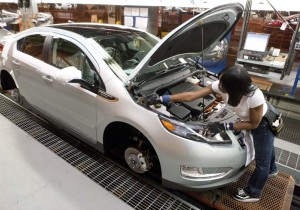
GM will temporarily shut down the plant where the Chevrolet Volt is built for retooling and to allow for expanded production.
General Motors’ Detroit-Hamtramck Assembly plant, home of the Chevrolet Volt, will close for four weeks beginning in June for planned upgrades to prepare for a significant increase in the rate of Volt production, along with assembly of the 2013 Chevrolet Malibu midsize sedan.
Already in tight supply, the number of Volts available for delivery to retail customers will be further restricted before production resumes. At that point, GM will begin producing the Volt and the Opel Ampera for export to Europe and China.
“The Volt will be available to customers nationwide by the end of 2011,” said Cristi Landy, director of Chevrolet Volt marketing. “By taking the time to reconfigure the plant, we will be better able to meet the tremendous consumer demand.”
The 2011 Volt was initially launched in California, New York, Connecticut, Maryland, Michigan, New Jersey, New York, Texas, Virginia and Washington, D.C. The Volt will be available nationwide and in Europe, China and Canada by the end of this year.
As a result of the plant upgrades, planned Volt and Ampera production capacity this year will increase to 16,000 units, including exports and a fleet of several hundred demonstration units sent to U.S. dealers. The changes at the plant will allow GM to increase global production capacity to about 60,000 vehicles with an estimated 45,000 to be delivered in the United States in 2012.
During the four-week shutdown the plant will complete some pre-scheduled upgrades, including the installation of new tools, equipment and overhead conveyor systems throughout the facility. This will prepare the plant for 2012 Volt and Ampera production and continue work on projects in preparation to launch the 2013 Malibu next year.
Coupled with already low dealer inventories and strong demand, the suspension of production, will result in limited availability and reduced sales in June and July.
The Volt is an electric vehicle that offers a total driving range of 379 miles, based on EPA estimates. For the first 35 miles, the Volt can drive gas- and tailpipe-free using a full charge of electricity stored in its 16-kWh lithium-ion battery. When the Volt’s battery runs low, a gas-powered engine/generator seamlessly operates to extend the driving range another 344 miles on a full change.
The electric driving range is enough for most drivers to make their daily commute to work and back without firing the gas engine, GM has said. But because it has a gasoline engine, it can be refueled as needed for longer trips.

How good are the Volts selling compared to what GM thought the sales would be by this time?
There’s a lot of debate over that, but it appears that sales have been running at roughly a 5,000 annual level and that most dealers are short of supply. Some observers claim not, but I know potential buyers around the country who have been sitting and waiting, one in Ann Arbor until recently told he might be able to get his until 2013. The expansion of capacity should bring him back into the showroom a good bit sooner.
Leaf sales were slightly lagging Volt’s until Nissan began ramping up production recently, so there’s reason to believe the upcoming changes at the “Poletown” plant, tripling the output of the Chevy plug-in should be well-received.
The real question is not whether Volt…or Leaf…will sell well now and in the next 6-12 months, but what happens after that. There are usually enough early adopters to maintain strong initial demand for any reasonably good, or at least interesting, breakthrough product. The more significant challenge is maintaining demand once those buyers have been satisfied.
Paul A. Eisenstein
Publisher, TheDetroitBureau.com